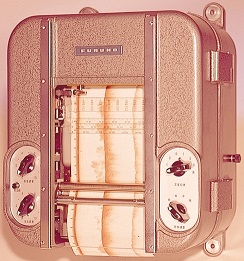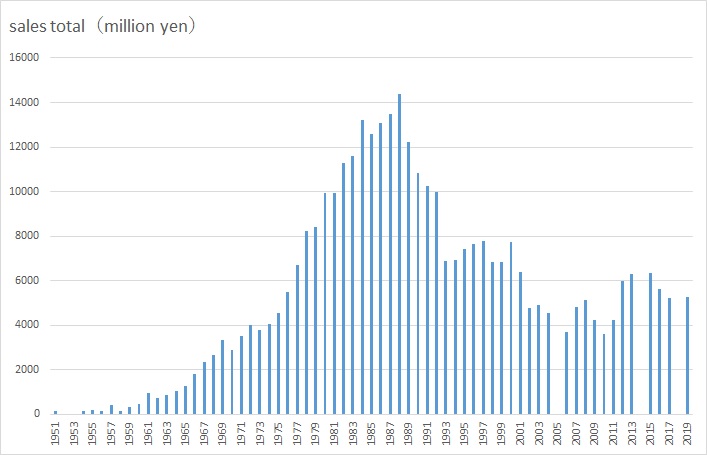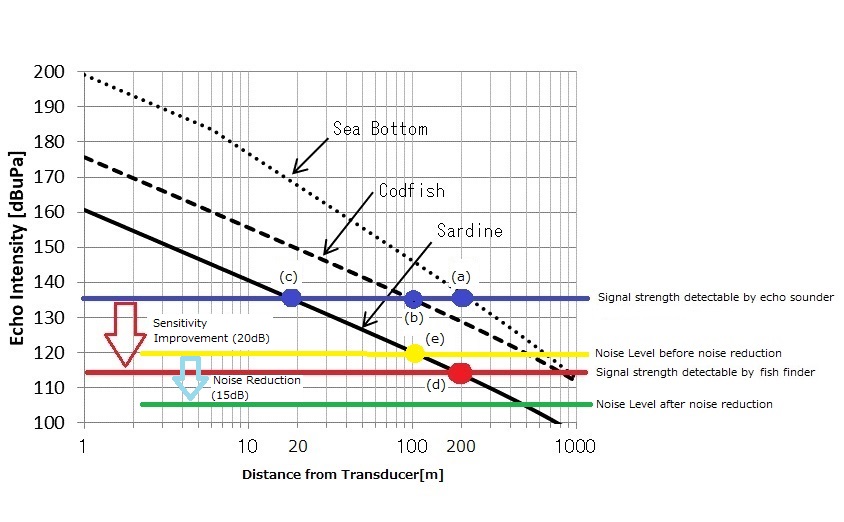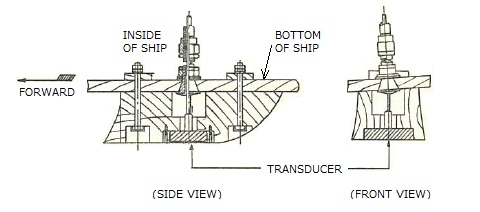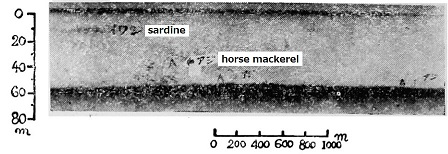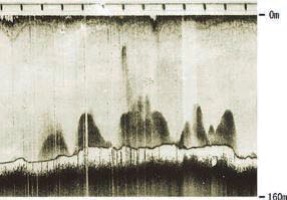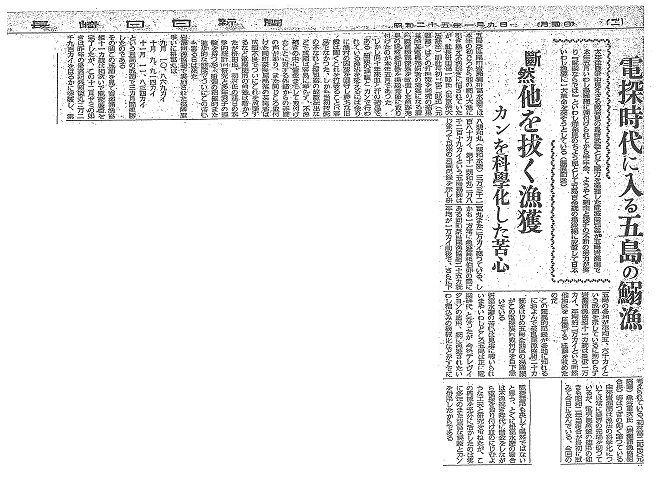Milestone-Proposal:FURUNO
To see comments, or add a comment to this discussion, click here.
Docket #:2021-01
This Proposal has been approved, and is now a Milestone
To the proposer’s knowledge, is this achievement subject to litigation? No
Is the achievement you are proposing more than 25 years old? Yes
Is the achievement you are proposing within IEEE’s designated fields as defined by IEEE Bylaw I-104.11, namely: Engineering, Computer Sciences and Information Technology, Physical Sciences, Biological and Medical Sciences, Mathematics, Technical Communications, Education, Management, and Law and Policy. Yes
Did the achievement provide a meaningful benefit for humanity? Yes
Was it of at least regional importance? Yes
Has an IEEE Organizational Unit agreed to pay for the milestone plaque(s)? Yes
Has the IEEE Section(s) in which the plaque(s) will be located agreed to arrange the dedication ceremony? Yes
Has the IEEE Section in which the milestone is located agreed to take responsibility for the plaque after it is dedicated? Yes
Has the owner of the site agreed to have it designated as an IEEE Milestone? Yes
Year or range of years in which the achievement occurred:
1949: ‘1949’ is the year when the Fish Finder was commercialized for the first time by Furuno Electric Co., Ltd.
Title of the proposed milestone:
Commercialization of the Fish Finder, 1949
Plaque citation summarizing the achievement and its significance; if personal name(s) are included, such name(s) must follow the achievement itself in the citation wording: Text absolutely limited by plaque dimensions to 70 words; 60 is preferable for aesthetic reasons.
In 1949, Furuno Electric Company, Ltd. successfully commercialized the world’s first fish finder. Unlike echo sounders that detect strong echo signals from the seabed, the fish finder used an improved reception amplifier to detect weak echo signals reflected from fish schools, and ultrasonic transducers that protruded from the fishing boat’s bottom to minimize the influence of sailing noise. Fish finders dramatically reformed the fishery industry in Japan, and subsequently worldwide.
200-250 word abstract describing the significance of the technical achievement being proposed, the person(s) involved, historical context, humanitarian and social impact, as well as any possible controversies the advocate might need to review.
The fish finder is a device that transmits ultrasonic waves into the water and receives the reflected waves to visualize and detect fish schools. The Japanese brothers Kiyotaka Furuno and Kiyokata Furuno commercialized the fish finder that could reliably detect fish schools. They improved the reception amplifier of the echo sounder that was used for surveying sea depth to detect the weak reception signal reflected by fish school, and they devised installing methods for installing ultrasound transducers at the bottom of a wooden ship to minimize the influence of noise caused by bubbles. The developed fish finder succeeded in accurately detecting sardine fish school in 1949, dramatically improving the catch and rapidly spreading as an indispensable equipment for fishing. The improved catch helped to secure Japan's protein resources, which had been in short supply after World War II, and contributed to the stability of Japanese life. Today, fish finders are equipped on almost every fishing boat in the world. The invention of the fish finder has an extremely important historical value in that it has brought about a revolutionary change in fisheries by giving a "scientific eye" to fisheries that had previously relied solely on the intuition and experience of fishermen, and electrical technology has brought about the modernization of the fisheries industry.
IEEE technical societies and technical councils within whose fields of interest the Milestone proposal resides.
IEEE Oceanic Engineering Society
In what IEEE section(s) does it reside?
IEEE Kansai Section
IEEE Organizational Unit(s) which have agreed to sponsor the Milestone:
IEEE Organizational Unit(s) paying for milestone plaque(s):
Unit: IEEE Kansai Section
Senior Officer Name: Yutaka Hata
IEEE Organizational Unit(s) arranging the dedication ceremony:
Unit: IEEE Kansai Section
Senior Officer Name: Yutaka Hata
IEEE section(s) monitoring the plaque(s):
IEEE Section: IEEE Kansai Section
IEEE Section Chair name: Yutaka Hata
Milestone proposer(s):
Proposer name: Isao Shirakawa
Proposer email: Proposer's email masked to public
Proposer name: Yasushi Nishimori
Proposer email: Proposer's email masked to public
Proposer name: Takeshi Fujii
Proposer email: Proposer's email masked to public
Please note: your email address and contact information will be masked on the website for privacy reasons. Only IEEE History Center Staff will be able to view the email address.
Street address(es) and GPS coordinates in decimal form of the intended milestone plaque site(s):
Furuno Electric Co., Ltd. : Address: 9-52 Ashihara-cho, Nishinomiya, 662-8580 Japan; GPS coordinates: N 34.741282, E 135.354547
Describe briefly the intended site(s) of the milestone plaque(s). The intended site(s) must have a direct connection with the achievement (e.g. where developed, invented, tested, demonstrated, installed, or operated, etc.). A museum where a device or example of the technology is displayed, or the university where the inventor studied, are not, in themselves, sufficient connection for a milestone plaque.
Please give the details of the mounting, i.e. on the outside of the building, in the ground floor entrance hall, on a plinth on the grounds, etc. If visitors to the plaque site will need to go through security, or make an appointment, please give the contact information visitors will need. The entrance hall of Furuno Electric Co., Ltd.
Are the original buildings extant?
The original building is extant and belongs to Furuno Electric Co., Ltd.
Details of the plaque mounting:
The plaque will be displayed at the entrance hall of Furuno Electric Co., Ltd.
How is the site protected/secured, and in what ways is it accessible to the public?
The plaque will be displayed in a showcase at the entrance hall of Furuno Electric Co., Ltd., which can be accessible to the public.
Who is the present owner of the site(s)?
Mr. Yukio Furuno, President of Furuno Electric Co., Ltd.
What is the historical significance of the work (its technological, scientific, or social importance)? If personal names are included in citation, include detailed support at the end of this section preceded by "Justification for Inclusion of Name(s)". (see section 6 of Milestone Guidelines)
Historical Significance
Background
During and after World War II, Kiyotaka Furuno engaged installing and repairing electric equipment on fishing boats in Nagasaki Prefecture, Japan. While working electric construction on fishing boats, he came to believe that the fishery was left behind from progress of science and technology.
Conventional fishing had been uncertain, with the inability to see under the sea, forcing fisherman to rely only on the experience and intuition.
The accomplishment of a fish finder
In December 1945, Kiyotaka Furuno started to develop a fish finder that could directly find schools of fish in the sea and know the size of the schools, the depth at which they swam, and even the species of fish schools.
Kiyotaka Furuno decided to apply ultrasonic technology to detect fish school. He obtained an echo sounder from the goods released by the old Japanese Navy to the civilian market and began experimenting. He spent almost a year making the first fish finder by improving the echo sounder. The first experiment was conducted in April 1947. Although the noise caused by the running of the ship had a large effect, it was confirmed that if such noise could be removed, it was possible to detect a school of fish using a fish finder.
Kiyotaka Furuno continued to improve and devise fish finders, and in May 1948, he succeeded in using fish finders to find schools of fish and catch them. In this way, the prospect of selling fish finders as a product was established.
In December 1948, Kiyotaka Furuno established Furuno Electric Industries, Ltd. and began full-scale sales of fish finders. At this point, the fish finder was capable enough to detect schools of fish. Nonetheless, at the time of its launch, many fish finders were returned to Furuno Electric. This was because fishermen could not use fish finders well. To bring out the most effect of the fish finders, fisherman had to change the way of fishing.
In May 1949, the great opportunity arose to demonstrate the effectiveness of fishing using fish finders. Furuno Electric came to be obliged the help of Mr. Tomiichiro Masuda, the owner of a boat called Masutomi Maru in the fishing village of Iwaseura. The Masutomi Maru was the vessel with the lowest catch in Iwaseura Village. The Masutomi Maru came to been equipped with a fish finder, Kiyokata Furuno who was Kiyotaka Furuno's younger brother, served as the chief fisherman for a temporary. The result was that the Masutomi Maru recorded the highest catch in Iwaseura Village, for three months.
Due to this success, the usefulness of fish finders was recognized by other fishermen in Iwaseura village, and in October 1949, all boats in Iwaseura were equipped with fish finders. In November 1949, the fleet in Iwaseura Village, where all boats were equipped with fish finders, recorded three times the catch of the fleet in the neighboring village which used to have a catch similar to the catch of Iwaseura Village.
Historical Significance
The great success of a fish finder in a small village in Nagasaki prefecture was featured in a newspaper article in January 1950 [11]. Fishermen who saw this article flooded Furuno Electric with inquiries about fish finders. This led to the spread of fish finders from Nagasaki Prefecture to all over Japan and the world.
The use of fish finders has made it possible to efficiently locate schools of fish without relying on the experience of fishermen, resulting in a dramatic increase in catches. Today, every fishing vessel in the world has a fish finder installed to find schools of fish. As a result, the launch of fish finders has contributed significantly to the expansion of global fish catches.
In this respect, the social impact and technological history value are extremely large [3],[4],[5],[6],[7],[8],[9],[10],[11],[12].
Fig.1 Recorder of a fish finder
Graph A shows changes in the sales total of fish finders in Japan [13], [14].
Graph A: Changes in the sales total of fish finders in Japan.
Justification to confirm the content of the Citation and show evidence on the proposal
In May 1948, Furuno discovered a school of fish with a fish finder and succeeded in capturing a school of fish in a sea experiment on a ship called the Chosei Maru, proving that fish finders could be used in actual fishing [9]. At this time, the fish finder was completed as practical machine. In December 1948, Kiyotaka Furuno established Furuno Electric Co., Ltd. and began full-scale sales of fish finders. However, at the beginning of the next year, there was a flurry of returns. In order to actually get the business off the ground, it was necessary to prove that the use of fish finders could significantly improve the catch. In May 1949, with the cooperation of a vessel named Masutomi Maru, which had the lowest catch in Iwaseura Fishing Port, Kiyokata Furuno served as a temporary chief fisherman and practiced fishing using fish finders, and as a result, he achieved the highest catch at Iwaseura Fishing Port from August to October, proving that fish finders can bring about a significant increase in catches[12]. Following this success, it was decided that all Iwaseura vessels would be equipped with fish finders in October. In November, the fleet of Iwaseura caught about three times as much as the fleet of Narao in the neighboring village, which always had the same catch as Iwaseura. This was picked up by a local newspaper in Nagasaki Prefecture[11], which led to the spread of fish finders throughout Nagasaki Prefecture, Kyushu, and Japan. In this newspaper article, Furuno Electric was introduced as "an electrical engineer in Nagasaki Prefecture". In reference [3], it is described that Kaijo Electric promoted the installation of fish finders, but it should be noted that Kaijo Electric was a company that sold echo sounders, which were the materials for fish finders, to Furuno Electric. The company that converted the echo sounder which were provided from Kaijo Electric into a fish finder and sold it to fishing boats was Furuno Electric.
What obstacles (technical, political, geographic) needed to be overcome?
Obstacles to overcome
Furuno's fish finder business faced a number of obstacles, but they were overcome as follows.
Enhancement of Built-in amplifier’s amplification
Figure 2 shows the basic configuration of a fish finder developed in 1948 [6].
Fig.2 the basic configuration of a fish finder
The fish finder consists of an ultrasonic transducer for transmission, an ultrasonic transducer for receiving, a transmitting circuit, a receiving circuit, and a recorder. An electric pulse is applied from the transmitting circuit to the transmitting ultrasonic transducer to send the ultrasonic pulse into the water, and the reflected pulse from the school of fish or the seabed is received by the receiving ultrasonic transducer. The received signal passes through the receiving circuit, amplified by an amplifier and enters the recorder. The recorder consists of a pen-shaped electrode to which a signal rectified by a rectifier was applied, a recording paper (potassium iodide starch paper) mechanically fed out, and a metal plate on the back of the recording paper. The pen-shaped electrode moves across the recording paper at a constant speed in synchronization with the timing of transmitting and receiving ultrasonic waves. Then, when an echo from a school of fish is received, a voltage is applied between the pen electrode and the metal plate on the back of the recording paper, and the paper develops a bluish-purple color. In this way, the color of the recording paper develops in the part corresponding to the school of fish. The depth to the school of fish can be known by using the formula D=VT/2. Where, D[m]: distance from the oscillator to the school of fish, V[m/s]: speed of sound in the water, and T[s]: time delay from transmission to reception.
Conventional echo sounders detect strong echo signals from the seabed, while fish finders need to detect weak echo signals from schools of fish. As a result of trial and error, Kiyotaka Furuno discovered that it was possible to detect schools of fish by increasing the amplification factor of a conventional echo sounder by about 20 dB, as can be seen from Fig. 3. (Please note that in Figure 3, the x-axis is the distance between the target and the transducer, and the y-axis is the received intensity of the reflected wave from the target.)
In Figure 3, the echo sounder Furuno obtained from Japanese Navy was designed to detect the seabed at a depth of 200 m, and it could detect ultrasonic waves with a sound pressure of 135 dBuPa (as shown by blue line) from the seabed at a depth of 200 m (point (a) of Figure 3). For this reason, large fish such as cod could be detected even at a depth of 100 m (point (b) of Figure 3), but small fish such as sardines could only be detected at shallow depths of around 20 m (point (c) of Figure 3).
Making the sensitivity of the echo sounder increased by 20 dB, it would be able to receive ultrasonic waves with a sound pressure of 115 dBuPa (as shown by red line), and it would be possible to detect common sardines swimming at a depth of 200 m (point (d) of Figure 3) on the continental shelf. It was sufficient as a fish finder. (Note that “dBuPa” is unit for ultrasonic relative intensity when 1uPa(=10^(-6)Pa) as 0dB.)
Kiyotaka Furuno increased the amplification factor by adding a vacuum tube amplification circuit to the receiver amplifier of the echo sounder. This modification made it possible to reliably receive weak echoes from schools of fish [9].
fig.3 Intensities of echo signals reflected from sea bottom and fish schools of codfishes/sardines. (Transmitted sound pressure level: 210dBuPa where Depth: 1m, Pulse width: 1ms, Beam angle: 27-degree, Frequency: 14.5 kHz)
Noise Suppression
Fish finders were very sensitive, so there was a problem of picking up various noises generated when fishing boats were running. As the speed of the vessel increased, the entire recording paper of the fish finder was blackened by the noise, and the echoes from the schools of fish were sometimes masked by the noise and could not be seen.
There were various sources of noise inside the fishing boat, including the electrical wiring of the engine, pumps, and fishing lights. Furuno Electric identified the causes of these noises one by one for each vessel and took measures such as keeping the transducers away from noise sources and shielding the electrical wiring.
The noise that was most difficult to take measures was the noise caused by the bubbles that enveloped around the ship resulting from the bow cutting the water when the ship sailed. This noise increased as the ship speed increased. When Furuno Electric began experiments, the transducers of fish finders were attached to the broadside, and the fish finder was strongly affected by the noise caused by bubbles.
The yellow line (120 dBuPa) in Figure 3 represents the noise level received by the receiver mounted on the broadside when the ship was sailing. The noise level represented by this yellow line is lower than the minimum reception sensitivity of the echo sounder (135 dBuPa), so the echo sounder was able to detect the seafloor depth without being affected by the noise caused by bubble. On the other hand, for the fish finder, the strength of the noise caused by bubble was equivalent to that of the echo signal reflected by a school of sardine at 100 [m] as shown by point (e). As a result, the recording paper of the fish finder turned entirely black, and even if there was a school of fish, it was difficult to distinguish the fish echo from the noise.
To solve this problem, Furuno Electric devised a method of mounting transducers by protruding from the bottom of the ship as shown in Figure 4. As a result of this measures, the noise level became the level represented by green line (105 dBuPa). This was lower than the noise revel when the transducers was mounted on the broadside by 15 dB. Thus, the noise revel caused by bubble came to be lower than the minimum reception sensitivity of the fish finder (115 dBuPa), and fish finders could now clearly record echoes from schools of fish.
fig.4 equipment manner of transducer on the bottom of wooden ship
Backlash from fishermen
Immediately after launching the fish finder in 1949, the first thing Furuno Electric faced was the prejudice of fishermen against fish finders. Fishermen, especially the chief fishermen, had relied on many years of experience and intuition to fish. They were confident that they would not have to resort to machines like fish finders.
Furuno Electric had succeeded in changing fishermen's prejudices against fish finders by actually dramatically improving the amount of catches.
Popularization of the use of fish finders
Furuno Electric had published a booklet as shown in Fig. 5 summarizing how to read the records of fish finders in 1952. The booklet contained records of fish discoveries obtained from fishing vessels, which were used to identify fish species, understand the ecology of fish schools, and improve fishing gear.
fig.5 Furuno's booklet on how to read the records of the fish finder
fig.6 the example of the records of the fish finder
As shown in Figure 6, schools of sardines are recorded in dots in the upper layer, and schools of horse mackerel are recorded in pyramids near the seafloor.
fig.7 the example of the records of the fish finder
In the Niigata record in Figure 7, schools of sea bream are triangular or square in shape and are characterized by dark-colored fish shadows that are closely attached to the seabed.
Furuno Electric not only sold fish finders, but also provided information on how to use fish finders and succeeded in increasing the number of users of fish finders [5],[6],[7],[8].
What features set this work apart from similar achievements?
Features make this work stand out from similar achievements
Prior Art
In Britain, an echo sounder was commercialized in 1933 to measure the depth of the ocean. This echo sounder was mounted on fishing vessels operating in the North Sea and was used to find suitable places for fishing.
In 1935, Norwegian fisheries scientist Oskar Sund reported that a school of cod was recorded using an echo sounder. In addition, a Canadian Fisheries Agency research vessel reported that in 1943 a school of herring was recorded on an echo sounder [1],[2].
Regarding the reports of these rare fish schools, it is thought that the echo from these schools of fish was able to be received by echo sounders because the schools of fish were composed of large fish such as cod, dense schools of fish, or schools of fish in shallow water. Conventional echo sounders were designed with low sensitivity because it was sufficient to be able to detect strong echoes from the seafloor. Thus, it was difficult to reliably capture faint echoes from common schools of fish.
Comparison with other companies
Conventional products from other companies were bathymetry devices (measuring the depth of the seabed), and the purpose was to search for fishing grounds at depths where schools of fish were likely to be. Therefore, even if a large school of fish could be seen by chance, it was not directly useful for fishing. On the other hand, Furuno Electric's goal from the beginning was to search for schools of fish with smaller reflected echoes than those on the seafloor. For this purpose, Furuno Electric increased the sensitivity of the receiver amplifier by 20 dB and implemented noise suppression measures associated with it. In this way, fish finders are now able to detect not only specialized schools of fish, but also many common schools of fish [9],[10].
Why was the achievement successful and impactful?
Supporting texts and citations to establish the dates, location, and importance of the achievement: Minimum of five (5), but as many as needed to support the milestone, such as patents, contemporary newspaper articles, journal articles, or chapters in scholarly books. 'Scholarly' is defined as peer-reviewed, with references, and published. You must supply the texts or excerpts themselves, not just the references. At least one of the references must be from a scholarly book or journal article. All supporting materials must be in English, or accompanied by an English translation.
[1] O. Sund, “Echo sounding in fishery research”, Letter to the Editor, Nature, p. 953, June 1935.
https://www.nature.com/articles/135953a0
[2] A. L. Tester, “Use of the echo sounder to locate herring in British Columbia Waters”, Bull. Fisheries Research Board of Canada, no. LXIII, pp. 3-21, 1943.
https://waves-vagues.dfo-mpo.gc.ca/library-bibliotheque/35610.pdf
[3] J. Saneyoshi, “Ultrasonic echo sounders and fish finders”, J. IEICE., vol. 34, no. 11, pp. 636-641, Nov. 1951 (in Japanese).
[citation]
[note] Section 3.5 of this paper describes the early popularization of fish finders. Although there is no direct mention of Furuno Electric's name, the passage that says, “The first to be effective in fishing operations were sardine net fishing boats near the Goto Islands in Nagasaki Prefecture” is an achievement by Furuno Electric. Initially, Furuno Electric had a cooperative relationship with Kaijo Electric, but Furuno Electric succeeded in developing fish finders independently from Kaijo Electric.
[4] J. Saneyoshi, “Ultrasonic fish finders and echo sounder”, The journal of the acoustical society of Japan, vol. 8, no. 2, pp. 59-65, Sep. 1952 (in Japanese).
https://www.jstage.jst.go.jp/article/jasj/8/2/8_KJ00001451600/_pdf/-char/ja
[note] This paper explains the rapid spread of fish finders throughout Japan, starting in Nagasaki Prefecture in Japan in 1950.
[5] A. Owatari, “The behavior of the Horse Mackerel school recorded by fish detector”, Bulletin of the Japanese Society of Scientific Fisheries Vol. 18, No. 8, 1953(in Japanese).
https://www.jstage.jst.go.jp/article/suisan1932/18/8/18_8_362/_pdf/-char/ja
[abstract] We studied, by means of fish-detector, the behavior of the horse mackerel schools caught by purse seine. Horse mackerel stay near the bottom of water, making a school of pyramidal shape during daytime (Fig. 1), but from some an hour after sunset, they move to the surface of the water for the seeking of food (Fig. 2).
[6] A. Owatari, “The Behaviors of the Sardine Schools by Fish-Detector”, Bulletin of the Japanese Society of Scientific Fisheries Vol. 18, No. 12, 1953(in Japanese).
https://www.jstage.jst.go.jp/article/suisan1932/18/12/18_12_669/_pdf/-char/ja
[abstract] We Studied, by means of fish-detector, the behavior of the sardine schools caught by purse seine with fishing light. Juvenile sardines were found near surface both daytime and night, and they were not attracted in schools by fishing light (Fig. 2). Mature sardine assembled in deeper (Fig. 3 A and B), and after sunset they formed schools spreading in the shape of belts (Fig. 3 C). With the advancing age, they gather more densely to the fishing light. With advancing age, they prefer deeper water (Fig. 5).
[7] A. Owatari, “The Behaviors of the Sardine Schools by Fish-Detector-II” , Bulletin of the Japanese Society of Scientific Fisheries Vol. 19, No. 11, 1954(in Japanese).
https://www.jstage.jst.go.jp/article/suisan1932/19/11/19_11_1072/_pdf/-char/ja
[abstract] We studied, by means of fish-detector, the behavior of the sardine schools in waters and their reaction to fishing light. From the experiments we found that sardine schools were not attracted by light when the water temperature did not seem to be suitable for the fish (Figs. 2-5 and 9.
[8] A. Owatari, “The Behaviors of the Sardine Schools by Fish-Detector-III. Behavior of Sardines When Attacked by Dolphin”, Bulletin of the Japanese Society of Scientific Fisheries Vol. 19, No. 12, 1954(in Japanese).
https://www.jstage.jst.go.jp/article/suisan1932/19/12/19_12_1144/_pdf/-char/ja
[abstract] A series of field tests has been carried out at a fishing ground (Fig. 1) to obtain schooling behavior of sardines gathering under a fishing lamp and their reaction when they were attacked on by dolphins, which are often the cause of fishermen's failure in catching sufficient amounts of fish. Plotted on Figs. 2 to 10 are images of sardines and dolphins recorded by a fish-detector. Each small spot near the surface represents an individual of dolphin, while a cloudy shadow is the reflection from a sardine school. Judging from these results we may presume that the sardine would escape very rapidly from an approaching shadow of the dolphin, and that the dolphin do not likely to swim deeper than 40 meters at any time as far as the present findings are concerned.
[9] J. Fujiwara, “Advance of echo sounder technology from the genesis to today”, The journal of the acoustical society of Japan, vol. 43, no. 9, pp. 706-707, Sep. 1987 (in Japanese).
https://www.jstage.jst.go.jp/article/jasj/43/9/43_KJ00001455310/_pdf/-char/ja
[note] The development of a fish finder by Furuno Electric is described. In this paper, Junichi Fujiwara wrote about the early spread of fish finders. Fish finders were first installed in April 1947, and although success in fishing using fish finders was achieved in May 1948, they were not widely used at this stage due to opposition from fishermen. It is stated that the fish finder installed on the fishing boat Masutomi Maru in 1949 was a great success, and that fish finders rapidly became popular.
[10] Japanese Patent Office, Selection from TOP 100 Japanese Innovations “Fish finders”, IP Friends Connections March 2018 No. 18, pp.72-78.
https://www.jpo.go.jp/e/news/kokusai/developing/training/enishi/document/index/enishi-18.pdf
[11] Article of Nagasaki News Paper, “Goto's sardine fishing enters the age of electric exploration. Catch that surpasses all others. Efforts that turned intuition into a science”, January 9, 1950 (in Japanese)
[citation]
[translation]
The era of fish finders has arrived in the sardine’s fishery of the Goto Islands
More than half a year has passed since the detection system, which was effective as a weapon for detecting invisible enemies during World War II, was installed on a sardines fishing boat in Iwaseura Fishing Village in the Goto Islands in May 1949. Finally, thanks to the hard work of the shipowner and crew, the fish finder has come to be recognized as the latest device for locating sardine fish. 100 groups of fishermen in the Goto Islands is rushing to install fish finders. A revolution is taking place sardine’s fishery in Japan.
Catches that far exceed those of others
The struggle to scientificize fisheries that rely on intuition
Since the beginning of 1949, Masutomi Fisheries, located in Iwaseura Village, Narao Town, Goto Islands, had been suffered by a lack of fishing despite the fact that other fishermen were catching large. In order to overcome this situation, in May 1949, President Tomiichiro Masuda (Graduated from Tokyo Imperial University) and Vice President Tomijiro Hatsumura (Former prefectural councilors) installed a fish finder on a fishing boat. This fish finder was invented by an electrical engineer in Nagasaki Prefecture by modifying an echo sounder. However, it was not easy to change the fishing method that was practiced by the experience and intuition of the boatmen, which had been continued through decades of hard work. Moreover, at first, due to unfamiliarity with new technology and a series of breakdowns of fish finders, the results of the catch did not improve easily, and there were voices of criticism for installing fish finders in debt while the poor fishing continued. At the same time, fishermen in Narao Village, Narao Town, who installed fish finders, finally abandoned the fish finder due to poor performance. Thus, the future of fish finders was dark, but thanks to Mr. Masuda and Mr. Hatsumura's daily scientific research and the active and progressive efforts of Mr. Sugimoto, a boatman with many years of experience, the hard work finally paid off. In the competition held at the Iwaseura Fishery Cooperative, Masutomi Maru won three months in a row with the best results of 10,869 boxes in September, 9,914 boxes in October, and 11,834 boxes in November. In the meantime, the 11 groups belonging to the Iwaseura Fishery Cooperative have successively completed the installation of fish finders. At the end of December, the record of 22,900 boxes recorded by the Shotoku Maru last year was exceeded. It is recoded that 8th Shinwa Maru (Shinwa Fisheries) caught 33,280 boxes, that is the highest record since the start of fishing in the Goto Islands, and the 11th Shinwa Maru caught 28,219 boxes, and the Masutomi Maru also caught 20,000 boxes. On the other hand, despite the fact that the average of the 25 groups in Narao, which is always in close competition with the Iwaseura Fishery Cooperative, is around 10,000 boxes in average and the various parts of the Shimogoto Islands show a record of 5,000 or 6,000 boxes, the 11 groups of the Iwaseura Fishery Cooperative have achieved a record of 10,000 boxes at least and 20,000 boxes in average, which exceed by far other regions. As a result of this astonishing record being known in various places, fishing boats in all areas of the Goto Islands, including the 20 groups of the Narao Fisheries Cooperative, are now rushing to install this fish finder. In this way, the hard work of Masutomi Fisheries has been rewarded splendidly, and the Goto Islands, which are famous for sardines, are truly in the age of fish finders, but the application of television and the mechanization of loading sardines caught in nets are already being considered in the future. Tomijiro Hatsumura (Former prefectural councilors) and Shigetsugu Uotani (President of Iwaseura Fishery Cooperative) have said the following. "Iwaseura has always been at the forefront of the industry in terms of the scientific development of fishing methods, but the use of electric fish collecting light was first attempted by the Iwaseura Fisheries Cooperative in 1927. In particular, in the case of Masutomi Fisheries, we installed a fish finder while borrowing money during the period when there was no fishing, and we had a lot of ingenuity and research. In fact, the reason why Masutomi Fisheries was able to make full use of the fish finder was because of its extensive experience and intuition over many years."
[note] This newspaper article reports that a fishing boat named Masutomi Maru, equipped with Furuno Electric's fish finder, had an amazing catch in the fall of 1949.
[12] NHK Publishing, inc., Project X vol. 10, pp. 104-157, “Fish Finder”, 2002
[note] In July 2001, Japan's national broadcaster (NHK) broadcast a documentary about the development of a fish finder by Furuno Electric. This book was published based on the content of the broadcast. Interviews with the people involved at the time of development are posted. In August 1949, Mr. Matsutaro Masuda of Masuda Fisheries testified about the situation when the ship named Masutomi Maru, equipped with a fish finder, caught a large amount of fish for the first time. The Masutomi Maru was equipped with transducers at the bottom of the ship during the rainy season, when fishing was closed. Mr. Masuda describes his excitement when a school of fish first appeared on a fish finder. "The fish finder started to write a faint record, but I could not determine what was it. I thought that if it was a school of fish, it would disappear after 10 minutes because the ship would pass over the school, but it didn't disappear after 10 or 20 minutes. I showed the radio operator the record and told him that if this was a school of fish, it would respond to the fishing lights. Before he finished listening to me, he called the mother ship immediately." (Page 153, lines 3 to 6) After receiving the report, Kiyokata Furuno riding on mother ship exclaimed, "It's a fish." The fish collection light was turned on, and after 30 minutes, the net was thrown. A large amount of sardines and horse mackerel was caught in the net. It was the largest catch since the beginning of Masutomi Fisheries.
[13] Japanese Ministry of Economy, Trade and Industry, Annual Report on Mechanical Statistics (1951-2001)
[14] Japanese Ministry of Land, Infrastructure, Transport and Tourism, Marine Industry Statistics Annual Report of Japan (2002-2019)
Supporting materials (supported formats: GIF, JPEG, PNG, PDF, DOC): All supporting materials must be in English, or if not in English, accompanied by an English translation. You must supply the texts or excerpts themselves, not just the references. For documents that are copyright-encumbered, or which you do not have rights to post, email the documents themselves to ieee-history@ieee.org. Please see the Milestone Program Guidelines for more information.
Please email a jpeg or PDF a letter in English, or with English translation, from the site owner(s) giving permission to place IEEE milestone plaque on the property, and a letter (or forwarded email) from the appropriate Section Chair supporting the Milestone application to ieee-history@ieee.org with the subject line "Attention: Milestone Administrator." Note that there are multiple texts of the letter depending on whether an IEEE organizational unit other than the section will be paying for the plaque(s).
Please recommend reviewers by emailing their names and email addresses to ieee-history@ieee.org. Please include the docket number and brief title of your proposal in the subject line of all emails.
